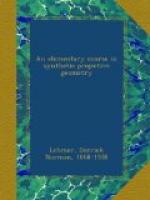176. Descartes and his influence. The history of synthetic projective geometry has little to do with the work of the great philosopher Descartes, except in an indirect way. The method of algebraic analysis invented by him, and the differential and integral calculus which developed from it, attracted all the interest of the mathematical world for nearly two centuries after Desargues, and synthetic geometry received scant attention during the rest of the seventeenth century and for the greater part of the eighteenth century. It is difficult for moderns to conceive of the richness and variety of the problems which confronted the first workers in the calculus. To come into the possession of a method which would solve almost automatically problems which had baffled the keenest minds of antiquity; to be able to derive in a few moments results which an Archimedes had toiled long and patiently to reach or a Galileo had determined experimentally; such was the happy experience of mathematicians for a century and a half after Descartes, and it is not to be wondered at that along with this enthusiastic pursuit of new theorems in analysis should come a species of contempt for the methods of the ancients, so that in his preface to his “Mechanique Analytique,” published in 1788, Lagrange boasts, “One will find no figures in this work.” But at the close of the eighteenth century the field opened up to research by the invention of the calculus began to appear so thoroughly explored that new methods and new objects of investigation began to attract attention. Lagrange himself, in his later years, turned in weariness from analysis and mechanics, and applied himself to chemistry, physics, and philosophical speculations. “This state of mind,” says Darboux,(14) “we find almost always at certain moments in the lives of the greatest scholars.” At any rate, after lying fallow for almost two centuries, the field of pure geometry was attacked with almost religious enthusiasm.
177. Newton and Maclaurin. But in hastening on to the epoch of Poncelet and Steiner we should not omit to mention the work of Newton and Maclaurin. Although their results were obtained by analysis for the most part, nevertheless they have given us theorems which fall naturally into the domain of synthetic projective geometry. Thus Newton’s “organic method"(15) of generating conic sections is closely related to the method which we have made use of in Chapter III. It is as follows: If two angles, _AOS__ and __AO’S__, of given magnitudes turn about their respective vertices, __O__ and __O’__, in such a way that the point of intersection, __S__, of one pair of arms always lies on a straight line, the point of intersection, __A__, of the other pair of arms will describe a conic._ The proof of this is left to the student.
178. Another method of generating a conic is due to Maclaurin.(16) The construction, which we also leave for the student to justify, is as follows: If a triangle _C’PQ__ move in such a way that its sides, __PQ__, __QC’__, and __C’P__, turn __ around three fixed points, __R__, __A__, __B__, respectively, while two of its vertices, __P__, __Q__, slide along two fixed lines, __CB’__ and __CA’__, respectively, then the remaining vertex will describe a conic._




